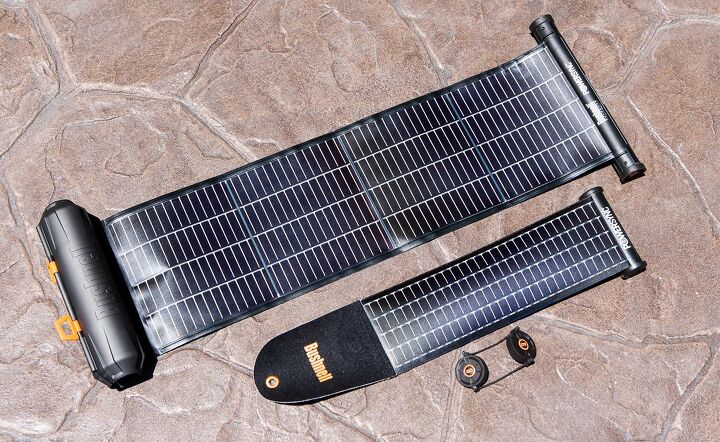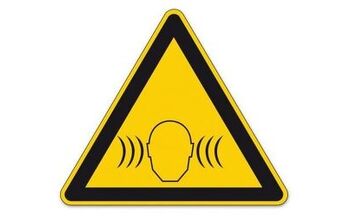Bushnell SolarWrap Mini and SolarWrap 400 Review

Portable Power for Charging Off the Grid
Modern technology has radically changed our lives, and not surprisingly, motorcycling reflects that change in many areas. While maybe not directly related to the act of riding a motorcycle, our portable technology permeates much of our daily life. Look at my recent review of the Scala Rider Q3 Multiset for a place I’d never really considered to be essential to my daily motorcycle use until I experienced it. However, there is one thing that most of these modern conveniences need to do their job: power – in the form of electricity.
While many touring bikes (and all their sub-categories) have 12-volt power outlets, most motorcycles still don’t offer any way to put juice back in your gadget’s depleted battery. To keep my power-hungry iPhone running for a full day on the road, I’ve taken to carrying a small portable battery in my jacket pocket. If I’m on the road for multiple days, say camping with my bike, the types of places I like to toss out my bedroll won’t have access to electricity to recharge my phone or the battery. When I stumbled upon Bushnell and its SolarWrap line of batteries, I figured my problem was solved, and a few months of living with a pair of SolarWraps has shown me that I was mostly right.
The SolarWrap Mini and the SolarWrap 400 both feature a 2200mAh Li-Ion battery as their power storage medium. What separates the two models is the surface area of their solar panels and their resulting charging times. Weighing in at just 3.1 oz. and measuring as a 4.3 x 1.25 in. cylinder when rolled up, the SolarWrap Mini has an USB mini charging port on one end and an USB power-out port on the other. To turn it on and start powering your portable device, simply plug the charging cable to your device and the output side of the Mini. It will continue to charge/power your device until empty. The 400 has the same input and output ports plus a couple additional features. First, a four-LED display tells the percentage of the 400’s charge. Also, the 400 will not accept or deliver power without a button being pressed to turn it on first.
In daily use, both the Mini and the 400 delivered about the same average charge to my iPhone 4S. From a completely dead 4S, the Mini would give an average of 78.5% charge while the 400 gave an average 77.0% charge. The charge times were similar to plugging the phone into a wall charger. If you have a larger gadget, like an iPad or another tablet, they tend to have higher power requirements (and larger batteries), so the charge times from the 400 and Mini will be longer and gain you a lower percentage of charge on your tablet.
One oddity that differentiates the Bushnell batteries from others that I’ve used is that the batteries did not turn themselves off when they were depleted. Instead, they continued to trickle the last power to the iPhone, causing it to chime that it had connected to a power source – only to lose the power connection and chime again a few seconds later. So, you probably don’t want to charge your phone while you sleep if it behaves the same way as an iPhone.
Both batteries took about four hours to charge when connected to wall power. The 400 ships with a USB wall adapter and cable, while the Mini only gives you a USB mini cable. However, USB chargers are so ubiquitous that this shouldn’t be an issue for most users.
Converting the sun’s rays into electricity is where these two wraps get to strut their stuff. Both batteries spool their flexible, thin film solar panels around the battery itself. The redundant wiring of the Bushnell panels means that only the individually damaged cell(s) is/are affected in the case of a mishap. Instead of rendering the panel inoperative, the solar power output simply drops by the percentage of power the damaged cells produced. Bushnell produced a video that shows the SolarWrap being shot three times with a pistol and still making over 99% of its original power.
The Mini’s solar panel is stored with hook-and-loop fastener that covers and protects the top several inches of the panel. When unfurled, the panel measures 4.3 x 17 in. The handy loop on the end makes it possible to hang it from a day pack while hiking. Although the Mini doesn’t require full, direct sun to charge its battery, more intense sunlight does shorten the charge time. My experience showed it to need almost 10 hours to go from depleted to fully charged.
No interaction with the Mini is required to start it charging. Lay it out in a place exposed to sunlight, and it will charge as soon as the intensity reaches the appropriate level. A handy LED turns red when the Mini is actively charging and green when complete. However, make sure you have the panel in full sun when checking the charge status, as the LED can give a false green in low light. Rubber end caps keep the USB ports safe for travel.
Everything about the SolarWrap 400 is bigger than the Mini – with one exception, the same 2200mAh Li-Ion battery. In full sun, the 400 charge time is reduced to almost that of AC power. The larger 9.2 x 29.25 in. solar panel cuts the charging process by more than half. With its panel stowed, the 400 is a 9.2 x 2.4 in. cylinder, weighing only 10.1 oz. The tough plastic exterior protects the panel from the dangers of transit. One functional difference with the Mini is that, to charge the 400, the power button must be pressed to turn the device on. Laying the panel out in full sun will do nothing until you press the power button. Similarly, you must press the power button before you can use the battery to charge your device. After 10 minutes of inactivity, the SolarWrap 400 automatically sleeps to conserve power. Every time the power button is pressed four LED lights flash to tell you the percentage of battery power, and during charging, the LEDs constantly display this information.
My experience with both the SolarWrap Mini and SolarWrap 400 showed them to be flexible tools for a mundane yet important task. I even carried the Mini partially unrolled in the map pouch of a tank bag to add a little juice between charges. The charging time is increased, but every little bit of power helps on the road. The larger 400 is more appropriate for use at a campsite rather than carrying around with you during the day, but the quickness of the charge can’t be understated. A side note, after a few weeks, the 400 began to overheat and shut down intermittently when charging in the sun. Suspecting that the battery was overheating, I covered the battery compartment with a white sheet of paper which allowed it to charge from empty to full without incident. Contacting Bushnell had the 400 replaced under its one-year warranty.
Unfortunately, the replacement exhibited the same symptoms. After consulting with the PR rep from Bushnell, I was informed, “The battery is indeed overheating. Manufacturer’s (Sanyo, etc.) specifications recommend not charging lithium-ion batteries above 40C/104F, and we have circuitry in place to cut off charging before it reaches this temperature. If you remember the Dell laptop fires several years ago, this is what caused them.
“We’re working on several design revisions for the next generation of this product, but in the meantime, you can cover the battery bar with a light-colored shirt/paper/etc. to keep it cool enough to continue charging. I’m sorry this isn’t the ideal solution, but our focus has been ensuring our lithium-ion batteries are safe for consumers, hence the cut-off circuitry.”
The SolarWrap Mini retails for $59.99, and I’ve found it to be a valuable tool for keeping my phone charged when I’m traveling. The only drawback is the time required to charge the battery by the sun, but that’s better than not being able to charge it at all. The pricier SolarWrap 400 is more difficult to recommend. At an MSRP of $199.99, the battery is expensive. The overheating problem – even though it is easily solved – makes it more difficult to justify the added expense. However, for people who don’t want to take a full solar day to recharge their batteries, the 400 may be a valid option.
Visit Bushnell’s website for more information and to find out where to purchase SolarWraps.

Like most of the best happenings in his life, Evans stumbled into his motojournalism career. While on his way to a planned life in academia, he applied for a job at a motorcycle magazine, thinking he’d get the opportunity to write some freelance articles. Instead, he was offered a full-time job in which he discovered he could actually get paid to ride other people’s motorcycles – and he’s never looked back. Over the 25 years he’s been in the motorcycle industry, Evans has written two books, 101 Sportbike Performance Projects and How to Modify Your Metric Cruiser, and has ridden just about every production motorcycle manufactured. Evans has a deep love of motorcycles and believes they are a force for good in the world.
More by Evans Brasfield

































Comments
Join the conversation
It's a hair larger, but the Joos Orange is my goto recharger. Big battery capacity, super tough, and seems to charge quickly (via solar or AC). I figure you could strap it inside your windshield and have it charge while you ride.
A useful item. But for a motorcycle? A simple (inexpensive!)12V USB power port, installed on the bike will provide all the recharging needs you could possibly require. Properly installed, a 12V USB can be virtually invisible, easily accessible and they do so without excess expense, fiddle or clutter. They also don't add to your already limited packing space and can not get misplaced.
One more thing, I don't need.